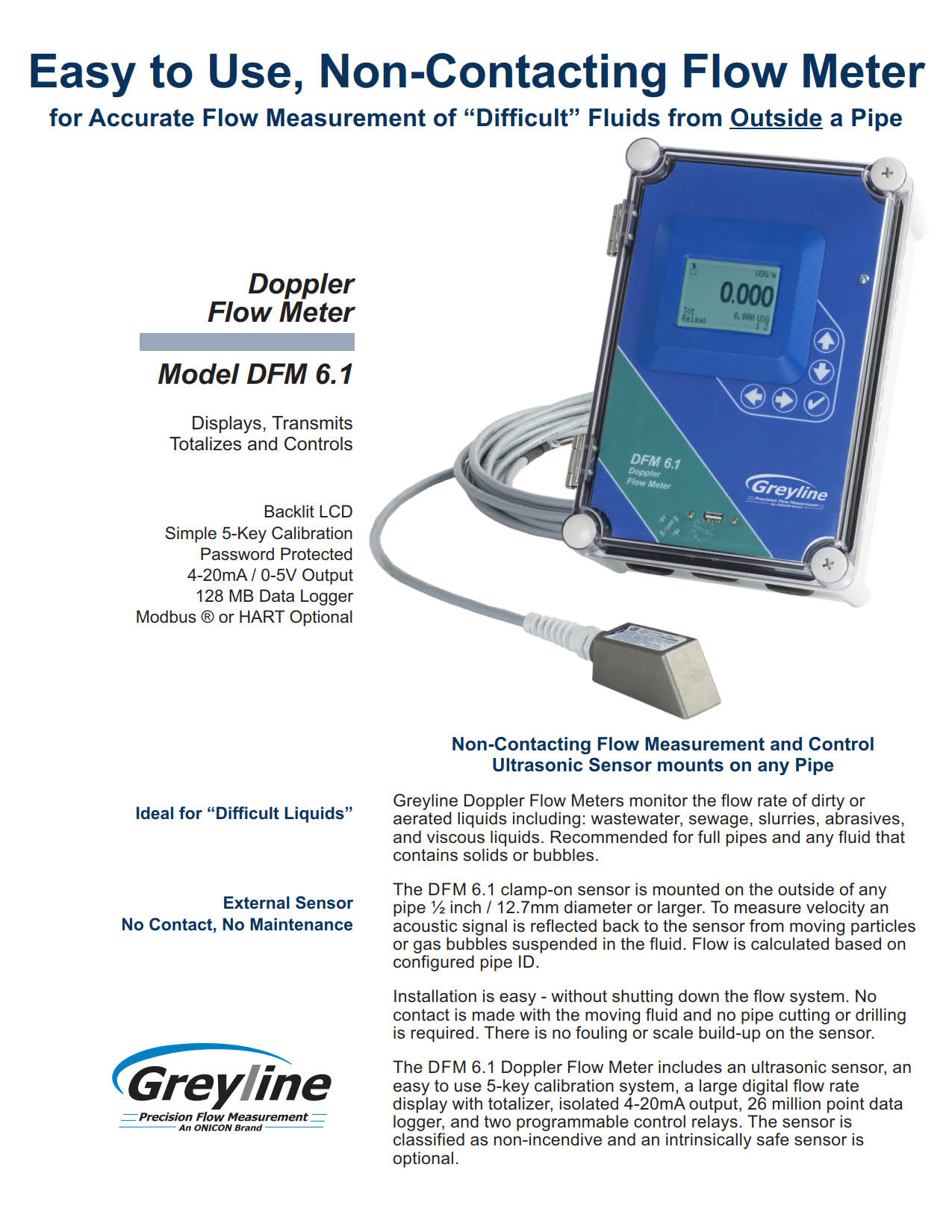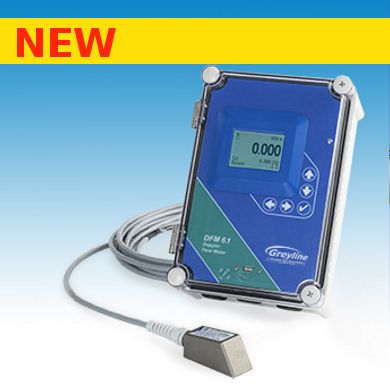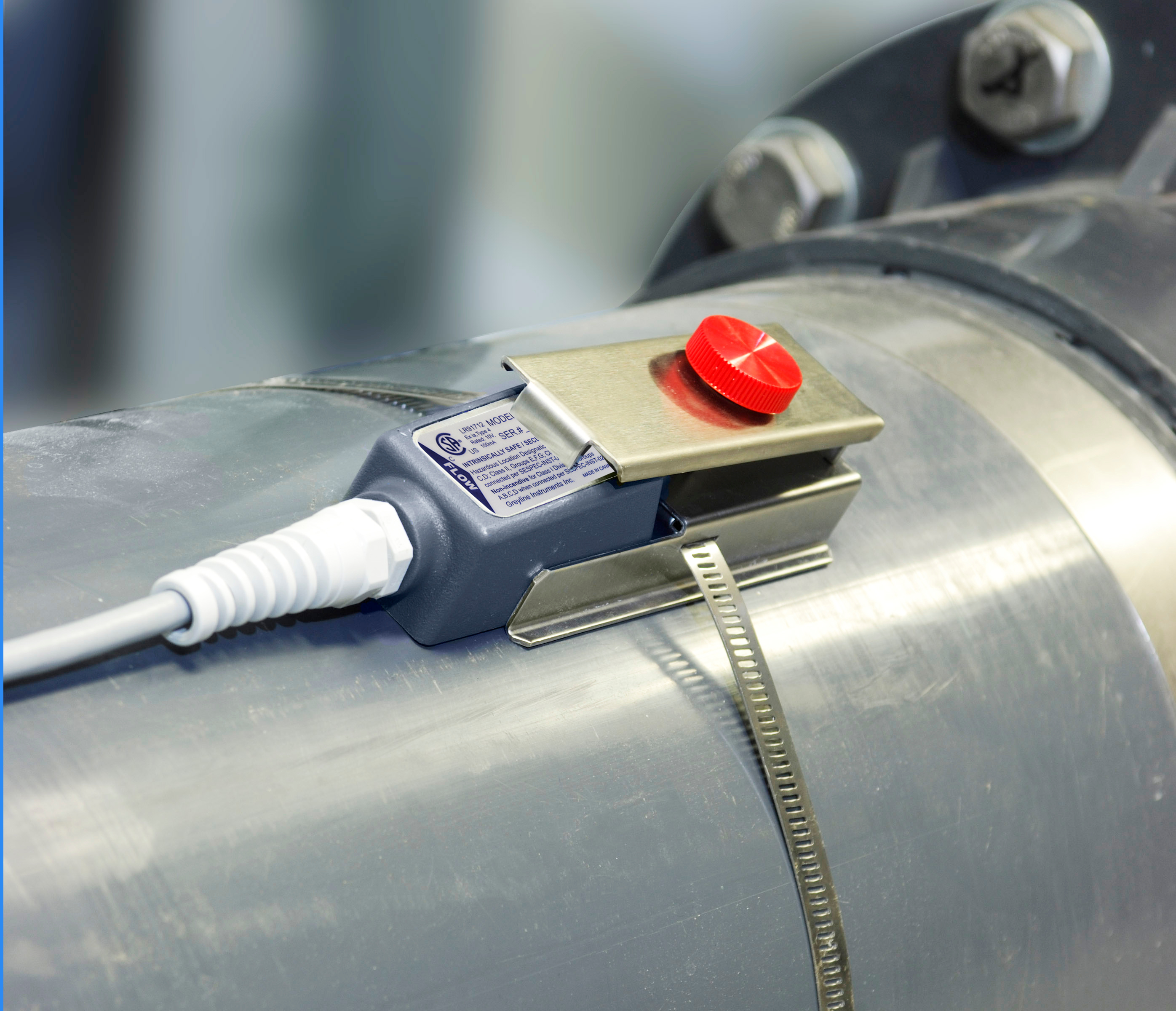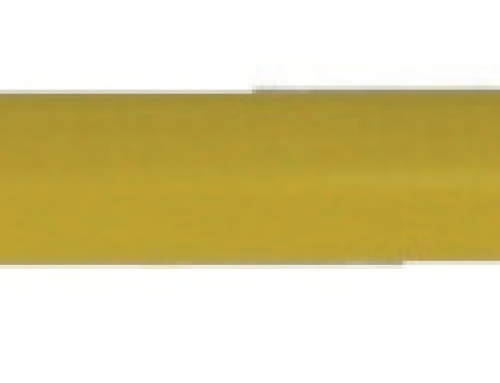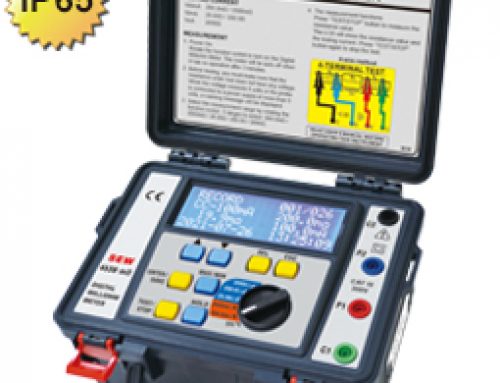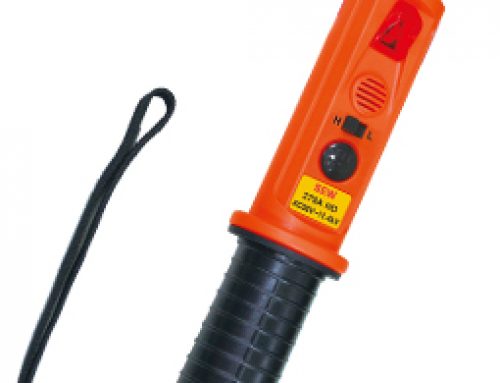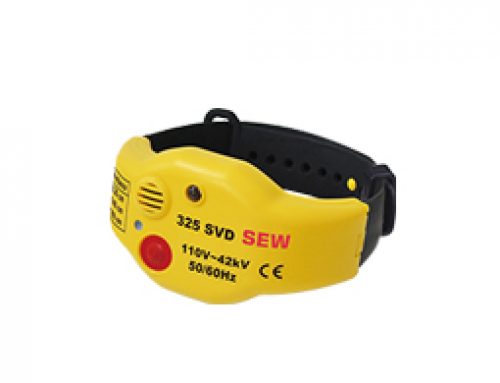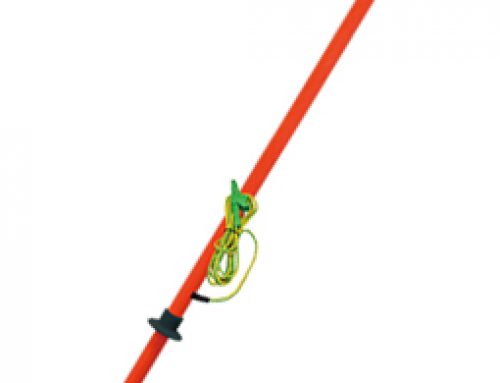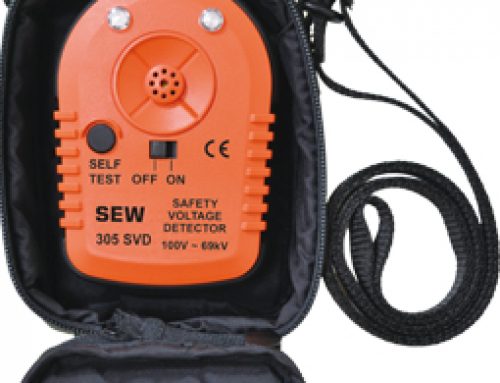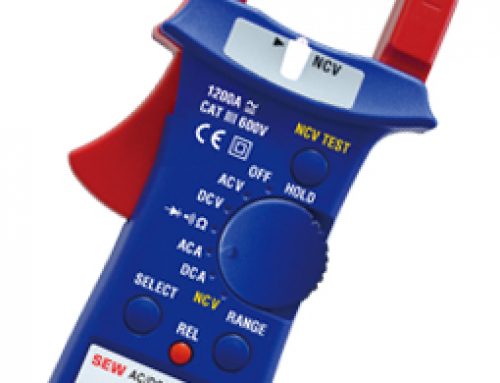- 增强的性能
- 易于安装和配置
- 非接触式钳式超声波传感器
- 适用于各种管材和尺寸
- 大型背光流量显示和累加器
- 隔离4-20mA输出
- 2个可编程控制继电器
- 可选MODBUS???RTU或HART输出
- 128MB数据记录器(2600万点)
DFM 6.1 Doppler Flow Meter
- Enhanced Performance
- Easy to Install and Configure
- Non-Contacting Clamp-On Ultrasonic Sensor
- Works on a Large Variety of Pipe Materials and Sizes
- Large Back-lit Flow Rate Display and Totalizer
- Isolated 4-20mA Output
- 2 Programmable Control Relays
- Optional MODBUS??RTU or HART Output
- 128MB Data Logger (26 million points)
测量管道外部的流量。Greyline DFM 6.1为“难以处理的液体”而设计,会损坏常规流量计 – 废水,浆液,污泥,化学品,粘性液体和磨料。没有阻碍流动和压力下降。非侵入式夹式超声波传感器适用于任何1/2英寸(12.5毫米)内径或更大的管道.DFM 6.1在各种应用中具有增强的性能。改进的工业噪声抗扰度可过滤潜在的干扰源。
使用隔离的4-20mA输出将流量传输到远程显示器,记录器或控制器。可编程继电器可用于流量控制,泵保护或流量比例脉冲。使用内置的5键校准器可轻松校准。在您选择的工程单位(加仑,升等)中显示和累计流量。128MB数据记录器是标准配置,能够捕获多达2600万个数据点。可选的MODBUS RTU通过HART可用于连接自动化系统。
传感器电缆可以延长至500英尺(152米),不会丢失信号。对于I类,2区危险场所,标准传感器的额定值为非易燃性,DFM 6.1可配备可选的本质安全栅,用于I类,I类危险场所的传感器安装。
Measure flow from outside a pipe. The Greyline DFM 6.1 is designed for “difficult liquids” that would damage regular flow meters – wastewater, slurries, sludge, chemicals, viscous liquids and abrasives. There is no obstruction to flow and no pressure drop. The non-intrusive, clamp-on ultrasonic sensor fits any pipe 1/2″ (12.5 mm) Inside Diameter or larger. The DFM 6.1 features enhanced performance in a wide range of applications. Improved industrial noise immunity filters potential interference souces.
Use the isolated 4-20mA output to transmit flow to remote displays, recorders or controllers. The programmable relays can be used for flow control, pump protection or flow proportionate pulse. Calibration is easy with the built-in 5-key calibrator. Display and totalize flow in your choice of engineering units (gallons, liters etc). A 128MB data logger is standard, capable of capturing up to 26 million data points. Optional MODBUS RTU via HART is available for connection to automation systems.
Sensor cable can be extended up to 500 ft. (152 m) with no loss of signal. The standard sensor is rated non-incendive for Class I, Division 2 hazardous locations and the DFM 6.1 can be equipped with optional Intrinsic Safety Barriers for sensor installation in Class I, Division I hazardous locations.
范围:本规范包括一个夹式超声波多普勒流量计,由Greyline Instruments Inc.,Largo,Florida/Long Sault,Ontario制造。仪表应提供非侵入式速度或流量测量、方向指示和全管流量传输。
A.性能规范
流量计应使用安装在连续管道材料外部的单头流量传感器进行操作,该管道材料可传导声音,包括但不限于:碳钢、不锈钢、球墨铸铁、水泥内衬球墨铸铁、铜、FRP、PVC或1/2“至180”(12.5 m m至4.5 m)ID的ABS管道。
在100微米或更大的夹带颗粒或气体且最小浓度为75 ppm的液体上,测量并指示从+0.1到+40 ft/sec和-0.1到-40 ft/sec(+0.03到+12.2 m/sec和-0.03到-12.2 m/sec)的流速,准确度为读数的±2%或±0.1 ft/sec,以较大者为准。
B.传感器(流量传感器)
流量传感器应为单头超声波不锈钢外壳。它应安装在管道外部,不会中断流量。传感器应能在-40°F至300°F(-40°C至150°C)的温度下连续工作,并能承受10 psi的意外淹没压力。应包括制造商推荐的耦合化合物和不锈钢安装夹。
应包括25 ft(7.6 m)传感器电缆、屏蔽同轴对。
应能够将传感器电缆延伸至500 ft(152m),无需操作员调整。
应隔离变压器,并设计为满足本质安全要求。应设计并进行CE测试,以获得工业噪声抑制。
传感器应为I级2类A、B、C和D组位置的非易燃性。
C.发射机
变送器指示器应安装在防水、防尘的NEMA4X(IP 66)聚酯和聚碳酸酯外壳内,带垫圈的防碎窗,适用于墙壁安装。
流量计电子设备应设计为在-10°F至140°F(-23°C至60°C)的温度下工作。电子电路可与其他具有相同型号的流量计互换。发射机电路和校准频率标准应为晶体控制。变送器应采用100-240VAC 50/60HZ供电,要求小于10 VA。
发送器应包括一个内置的5键编程系统,操作员可通过菜单系统的视觉提示选择参数。不接受需要通过参数代码或外部校准器编程的系统。
4-20mA输出应与流量成比例并隔离,具有可编程零点和满刻度偏移。最大电阻负载应为1000欧姆。
应包括用于过滤电气干扰的噪声抑制电路。
有一个白色的背光矩阵液晶显示器,显示流量和用户选择的工程单位,继电器状态,以及重要的诊断,如信号强度。
有2个额定电流为5安培的SPDT控制继电器。继电器应可编程用于流量比例脉冲输出,或作为具有单独开/关设定点的流量警报。
应显示并汇总正向和反向流量。
内置2600万点数据记录器,USB输出到闪存驱动器或大容量存储设备。包括用于打印和导出的Windows软件。
电子设备应为模块化,并可通过插入式电路板进行现场更换。仪器应自动检测和加载软件菜单,以供现场安装选项使用。
D.按要求插入规范的附加功能:
传感器的本质安全等级应为I级,C、D组;II级,E、F、G组;III级,带本质安全栅。
传感器电缆应为50 ft(15 m)长的屏蔽同轴对。
传感器电缆应为100 ft(30 m)长的屏蔽同轴对。
在导管中安装传感器电缆接线盒和总长度不超过500 ft(152m)的屏蔽同轴对电缆,以进行机械保护。
在温度低于-10°F(-23°C)的位置配备恒温控制的交流供电外壳加热器,以防冷凝。
电源输入为9-32Vdc,最大10瓦。
变送器应具有流量、总流量、前一天平均流量、前一天总流量和诊断值的串行通信。可通过RS-485或HART(公路可寻址远程传感器)在Modbus RTU之间进行现场选择。
E.制造商
仪器应为Greyline Instruments Inc.制造的DFM 6.1型多普勒流量计,并保证一年内不会出现材料和工艺缺陷。
如果您在申请中需要更多信息或建议,请联系Greyline。我们可以提供报价,并向贵公司所在地区的Greyline销售代表咨询。
SCOPE: This specification covers a clamp-on, ultrasonic Doppler flow meter, as manufactured by Greyline Instruments Inc., Largo, Florida / Long Sault, Ontario. The meter shall provide for non-intrusive velocity or flow measurement, direction indication, and transmitting of the flow rate in a full pipe.
- PERFORMANCE SPECIFICATIONS
The flow meter shall operate with a single-head flow sensor mounted externally on any contiguous pipe material that conducts sound including but not limited to: carbon steel, stainless steel, ductile iron, cement lined ductile iron, copper, FRP, PVC, or ABS pipe from 1/2″ to 180″ (12.5 mm to 4.5 m) ID.
Measure and indicate flow rates from +0.1 to +40 ft/sec and -0.1 to -40 ft/sec (+0.03 to +12.2 m/sec and -0.03 to -12.2 m/sec) with accuracy of ±2% of reading or ±0.1 ft/sec, whichever is greater, on liquids with entrained particles or gases of 100 microns or larger and minimum concentrations of 75 ppm.
- TRANSDUCER (FLOW SENSOR)
The flow sensor shall be single-head, ultrasonic in a stainless steel housing. It shall be installed on the outside of a pipe without interrupting flow. The sensor shall be capable of continuous operation at temperatures from -40°F to 300°F (-40°C to 150°C), and able to withstand accidental submersion pressures to 10 psi. Manufacturer’s recommended coupling compound and stainless steel mounting clamp shall be included.
Shall include 25 ft (7.6m) sensor cable, shielded coaxial pair.
Shall be capable of extending sensor cable up to 500 ft (152m) without requirement for operator adjustment.
Shall be transformer isolated and designed to meet intrinsic safety requirements. Shall be designed and CE tested for maximum industrial noise rejection.
Sensor shall be rated Non-incendive for Class I, Division 2, Groups A, B, C & D locations.
- TRANSMITTER
The transmitter indicator shall be housed in a watertight and dust tight NEMA4X (IP 66) polyester and polycarbonate enclosure with a gasketed shatter proof window, suitable for wall mounting.
Flow meter electronics shall be designed to operate at temperatures from -10°F to 140°F (-23°C to 60°C). Electronic circuits are interchangeable with other flow meters having the same model number. The transmitter circuit and calibration frequency standard shall be crystal controlled. The transmitter shall be powered by 100-240VAC 50/60Hz requiring less than 10 VA.
The transmitter shall include a built-in 5-Key programming system with operator selection of parameters through visual prompts from a menu system. Systems requiring programming by parameter codes or external calibrators shall not be accepted.
The 4-20mA output shall be flow proportional and isolated, with programmable zero and full scale offsets. Maximum resistive load shall be 1000 ohms.
Shall include noise suppression circuitry to filter electrical interference, and shall be tested for industrial noise immunity for CE certification, European Directive 2014/30/EU.
Shall be certified to UL/CSA/EN 61010-1.
Have a white, backlit matrix LCD display indicating flow rate and total in user-selected engineering units, relay states, and important diagnostics like signal strength.
Have 2 SPDT control relays rated 5 ampere. Relays shall be programmable for flow proportional pulse output, or as flow rate alarms with separate ON/OFF set points.
Shall display and totalize forward and reverse flow.
Have a built-in 26 million point data logger with USB output to flash drive or mass storage device. Includes Windows software for plotting and exporting.
Electronics shall be modular and field replaceable by means of plug-in circuit boards. The instrument shall detect and load software menus automatically for field-installed options.
- ADDITIONAL FEATURES FOR INSERTION IN SPECIFICATION AS REQUIRED:
Sensor shall be rated intrinsically safe to Class I, Groups C,D; Class II, Groups E,F,G; Class III with Intrinsic Safety Barriers.
Sensor cable shall be 50 ft (15m) length shielded coaxial pair.
Sensor cable shall be 100 ft (30 m) length shielded coaxial pair.
Have a Sensor Cable Junction Box and up to 500 ft (152m) length total shielded coaxial pair cable installed in conduit for mechanical protection.
Have a thermostatically controlled AC-powered enclosure heater for condensation protection in locations with temperature below -10°F (-23°C).
Have power input of 9-32VDC, 10 Watts maximum.
Transmitter shall have serial communications for flow rate, total, previous day average flow rate, previous day volume total, and diagnostic values. Field selectable between Modbus? RTU via RS-485 or HART (Highway Addressable Remote Transducer).
- MANUFACTURER
The instrument shall be a Model DFM 6.1 Doppler Flow Meter as manufactured by Greyline Instruments Inc., and warranted against defects in materials and workmanship for one year.
Please contact Greyline if you need more information or for advice in your application. We can provide quotations and refer you to the Greyline sales representative in your area.
流量计运作原理
仪器电子设备测量从发送声音到回声返回所需的时间。根据空气中的声速,可以高精度计算出液体表面与传感器的准确距离(0.25%范围)。
由于声速受空气温度的影响,灰线超声波液位传感器包括一个内置的温度传感器。水平/距离测量在传感器的整个工作温度范围内自动进行温度补偿。
传感器的位置应使其能清楚地“看到”液体表面,远离梯子、管道或其他障碍物。Greyline建议每10英尺深度距离侧壁1英尺(每3米深度300毫米)。来自搅拌器的假回波(在传感器下扫过)、湍流和波可以被仪器过滤和忽略。
Greyline模型的范围从简单的4-20mA液位指示发送器,到复杂的监控、控制和数据记录模型。返回greyline产品了解级别模型详细信息和规格。有关包括超声波在内的各种液位仪表技术的信息,请参阅废水液位测量技术。
测量管外脏污或充气液体的流量
多普勒效应由奥地利物理学家克里斯蒂安·多普勒于1842年提出。我们每天都能听到多普勒的例子:火车经过时的汽笛声改变音调,或者赛车驶过我们的位置时的排气噪音。
多普勒技术只适用于含有固体或气泡的液体来反射其信号。这些是“困难”的液体,可能会损坏常规流量计:泥浆、污泥、废水、磨料、粘性和腐蚀性化学品。由于传感器安装在管道外部,因此没有压降,也没有流动障碍物。
为了获得很好性能,多普勒传感器应安装在远离湍流产生装置(如弯管和三通)的地方,远离速度增加装置(如控制阀和泵)。典型精度为满刻度的±2%。多普勒仪器包括一个夹式超声波传感器、连接电缆和一个电子外壳,可以安装在附近方便的位置(500英尺/152米范围内)。传感器可以本质安全地额定安装在危险的额定位置。
需要非常精确的定时电路,但当传感器可以安装在流量均匀分布的管段上时,1%的精度非常典型。
由于超声波信号必须穿过管道到达接收传感器,因此流体中不得含有大量气泡或固体(小于2%)。否则高频声音会减弱,太弱,无法穿过管道。应用包括饮用水、冷却水、水/乙二醇溶液、液压油、燃油和化学品。
渡越时间传感器通常工作在1-2兆赫的频率。高频设计通常用于较小的管道,低频设计用于直径达数米的大型管道。
水槽和堰是专门设计的渠道形状,以表征水流。常见的类型有矩形堰、V型槽堰、Parshall水槽和Palmer Bowlus水槽。水槽或堰型的选择取决于应用:流速、渠道形状和水的固体含量。请联系Greyline Instruments以获取有关为您的应用选择合适水槽或堰的建议。
灰线明渠流量计可以通过菜单选择校准到水槽或堰。明渠流量计电子设备使用内部公式计算流量(流量=k h n,其中“k”和“n”为常数,“h”为仪器测量的压头)。通过直接输入“k”和“n”常数,可以对不常见或自定义水槽进行校准。Greyline还提供了一个PC软件程序“find k&n”,用于根据水槽或堰流图开发校准常数。
Greyline明渠流量计包括非接触式超声波传感器、连接电缆和电子外壳,可安装在附近方便的位置(500 ft/152 m内)。传感器可以本质安全地额定安装在危险的额定位置。仪器显示、汇总、传输和控制,有些型号包括数据记录/流量报告系统。
在没有水槽或堰的情况下测量明渠流量。面积速度流量计连续测量水位和流速,以计算明渠或管道中的流量。
超声波传感器安装在管道或通道的底部。为了测量水位,传感器发送超声波脉冲,这些脉冲通过水传播并从液体表面反射出来。仪器精确测量回声返回传感器所需的时间。根据水中声速,测量声级精度为±0.25%。
用连续注入水中的超声多普勒信号测量流速。这种高频声音(640kHz)从悬浮在液体中的颗粒或气泡反射回传感器。如果流体在运动,回声以与流速成比例的变化频率返回。利用该技术,仪器测量流速的精度为±2%。
greyline面积流速流量计工作在部分满管和溢流管、矩形、梯形和蛋形通道中。
可选-单独的液位和速度传感器
一个单独的向下看超声波传感器可用于高充气或湍流应用。它通过将超声波脉冲通过空气传输到液体表面来测量液位,精度为±0.25%。在水位传感器的基础上,采用水下多普勒速度传感器对水位进行测量。
HOW IT WORKS
The instrument electronics measure the time it takes from transmitted sound to return of the echo. With reference to the speed of sound in air, the exact distance of the liquid surface from the sensor can be calculated with high accuracy (±0.25% of maximum range).
Since the speed of sound is affected by air temperature, Greyline ultrasonic level sensors include a built-in temperature sensor. Level/distance measurements are automatically temperature compensated throughout the operating temperature range of the sensor.
The sensor should be positioned so that it has a clear “view” of the liquid surface and away from ladders, pipes or other obstructions. Greyline recommends 1 ft. from the sidewall for every 10 ft. depth (300 mm for every 3 m depth). False echoes from agitators (sweeping under the sensor), turbulence and waves can be filtered and disregarded by the instrument.
Greyline models range from simple 4-20mA level indicating transmitters, to sophisticated monitoring, controlling and data logging models. Return to Greyline Products for Level model details and specifications. For information on a wide range of level instrument technologies including ultrasonics, read Wastewater Level Measurement Techniques.
Doppler flow meters measure flow from outside a pipe with a clamp-on sensor. Greyline Doppler meters continuously transmit high frequency sound (640 kHz) that travels through the pipe wall and into the flowing liquid. Sound is reflected back to the sensor from solids or bubbles in the fluid. If the fluid is in motion, the echoes return at an altered frequency proportionate to flow velocity. Doppler flow meters continuously measure this frequency shift to calculate flow.
Measure Flow of dirty or aerated Liquids from Outside a Pipe
The Doppler effect was first documented in 1842 by Christian Doppler, an Austrian physicist. We hear everyday examples of Doppler: the sound of a train whistle changing pitch as it passes by, or the exhaust noise from a race car as it speeds past our location.
The Doppler technique only works on liquids which contain solids or gas bubbles to reflect its signal. These are “difficult” liquids that may damage regular flow meters: slurries, sludge, wastewater, abrasives, viscous and corrosive chemicals. Because the sensor mounts on the outside of the pipe, there is no pressure drop and no obstruction to flow.
For best performance Doppler sensors should be mounted away from turbulence creating devices like pipe elbows and tees, and away from velocity increasing devices like controlling valves and pumps. Typical accuracy is ±2% of full scale. Doppler instruments include a clamp-on ultrasonic sensor, connecting cable and an electronics enclosure which can be mounted at a convenient location nearby (within 500 ft / 152 m). Sensors can be rated intrinsically safe for mounting in hazardous-rated locations.
Very accurate timing circuits are required but 1% accuracy is quite typical when the transducers can be mounted on a pipe section with evenly distributed flow.
Because the ultrasonic signal must cross the pipe to a receiving transducer, the fluid must not contain a significant concentration of bubbles or solids (less than 2%). Otherwise the high frequency sound will be attenuated and too weak to traverse the pipe. Applications include potable water, cooling water, water/glycol solutions, hydraulic oil, fuel oils and chemicals.
Transit Time transducers typically operate in the 1-2 MHz frequencies. Higher frequency designs are normally used in smaller pipes and lower frequencies for large pipes up to several meters in diameter.
Flumes and weirs are specially designed channel shapes that characterize the flow of water. Common types are Rectangular Weirs, V-Notch Weirs, Parshall flumes and Palmer Bowlus flumes. The choice of flume or weir type depends on the application: flow rate, channel shape and solids content of the water. Contact Greyline Instruments for advice on selection of a suitable flume or weir for your application.
Greyline open channel flow meters can be calibrated to any flume or weir by menu selection. The open channel flow meter electronics use an internal formula to calculate flow rate (Flow = K Hn, where ‘K’ and ‘n’ are constants and ‘H’ is Head as measured by the instrument). Calibration to uncommon or custom flumes can be done by direct entry of ‘K’ and ‘n’ constants. Greyline also offers a PC software program “Find K&n” to develop calibration constants from a flume or weir flow chart.
Greyline open channel flow meters include a non-contacting ultrasonic sensor, connecting cable and an electronics enclosure which can be mounted at a convenient location nearby (within 500 ft / 152 m). Sensors can be rated intrinsically safe for mounting in hazardous-rated locations. The instruments display, totalize, transmit and control, and some models include data logging/flow reporting systems.
Measure open channel flow without a flume or weir An Area-Velocity Flow Meter continuously measures both Level and Velocity to calculate flow volume in an open channel or pipe.
The ultrasonic sensor is installed at the bottom of a pipe or channel. To measure water level the sensor transmits ultrasonic pulses that travel through the water and reflect off the liquid surface. The instrument precisely measures the time it takes for echoes to return to the sensor. Based on the speed of sound in water, the level is measured with accuracy of ±0.25%.
Flow velocity is measured with an ultrasonic Doppler signal continuously injected into the water. This high frequency sound (640 KHz) is reflected back to the sensor from particles or bubbles suspended in the liquid. If the fluid is in motion, the echoes return at an altered frequency proportionate to flow velocity. With this technique the instrument measures flow velocity with accuracy of ±2%.
Greyline Area-Velocity Flow Meters work in partially full and surcharged pipes, rectangular, trapezoid and egg-shaped channels.
Optional – Separate Level and Velocity Sensors
A separate down-looking ultrasonic sensor can be used for highly aerated or turbulent flow applications. It measures level by transmitting ultrasonic pulses through the air to the liquid surface with accuracy of ±0.25%. Along with the level sensor, a submerged Doppler velocity sensor is used to measure the water velocity.







